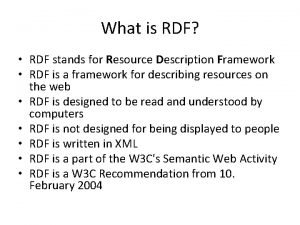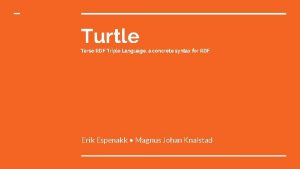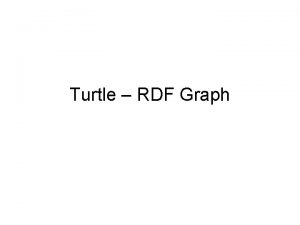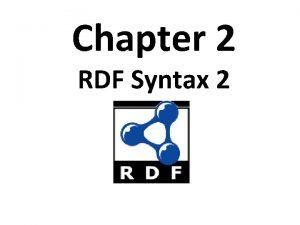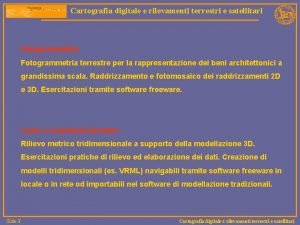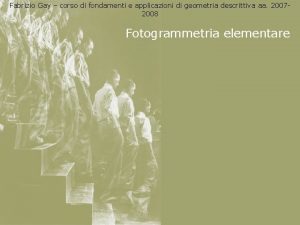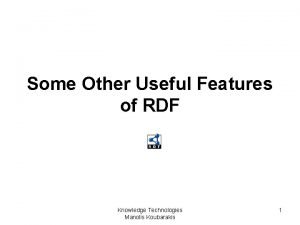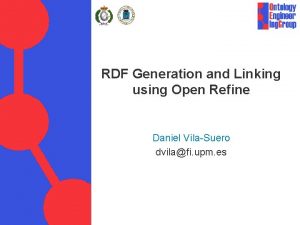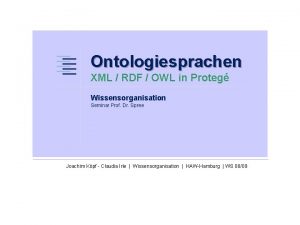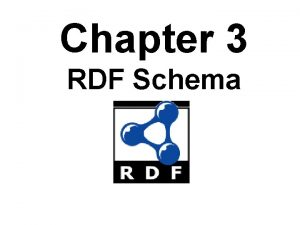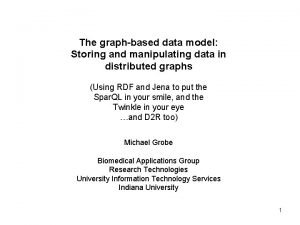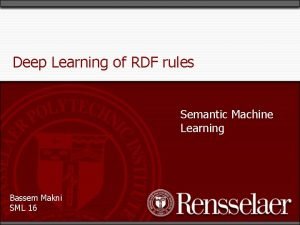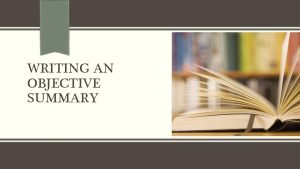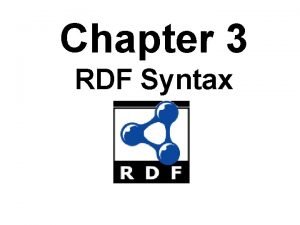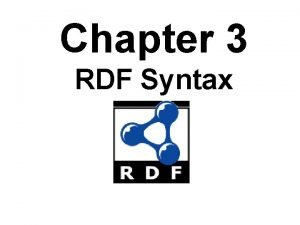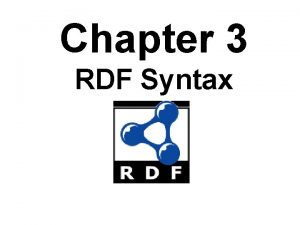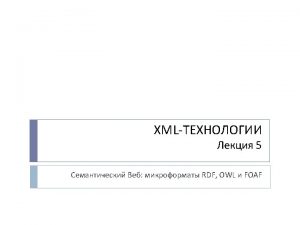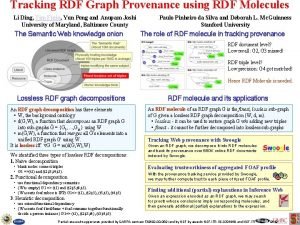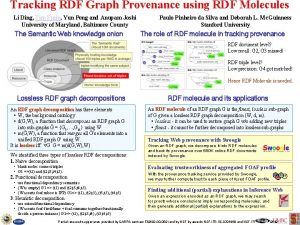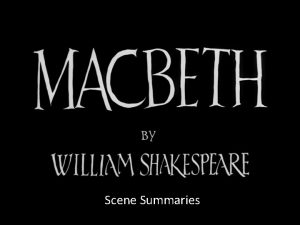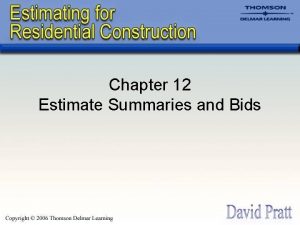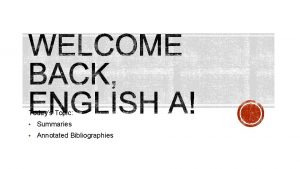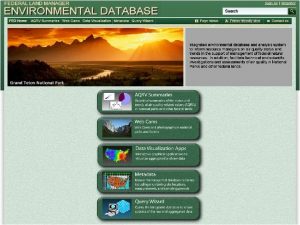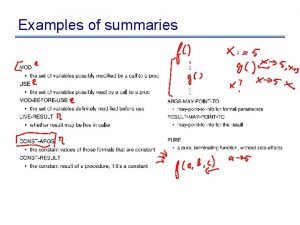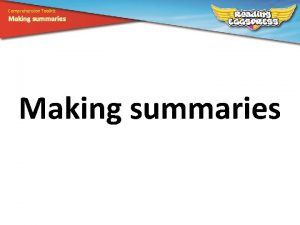RDF graph summaries 2014113 1 Graph Summary A
















- Slides: 16

RDF graph summaries 金成 2014/11/3 1

Graph Summary • A graph summary captures the information that represents the original data graph. • Most of summaries are the substitution of the data graph with a homomorphic graph, which contains ideally less nodes and edges with regards to the data graph. • Each approach produces different graph summary. [Picture from Campinas S, Perry T E, Ceccarelli D, et al. Introducing rdf graph summary with application to assisted sparql formulation[C]] 2

Pattern extraction 3

RDF graph sample db: player/1 eg: country “Argentina”; eg: birthday “ 1987/6/24”; rdf: type “player” eg: friends “Beckham” eg: teammate “neymar” eg: instrested. In “the roling stones” db: player/2 eg: country “England” eg: type “player” db: player/3 eg: country ”Brazil” eg: birthday” 1992/2/5” rdf: type “player” db: band/1 eg: manager: ”bob” eg: create “Far East Tour” eg: create “Voodoo Lounge” db: record/1 rdf type “Far East Tour” Db: record/2 rdf: type “Voodoo Lounge” Figure 2: A RDF graph Figure 3: RDF statements

DFS frequent pattern extraction DFS code: A 5 -tuple mapping of elements to integer. . i, j denote the discovery time of DFS search. The rest denote the Figure 4 original graph country birthday friends teammate properties instrested. In manager create player types of subjects band or objects record literal 1 2 3 4 5 6 7 8 9 10 0 Table 1: mapping of classes and properties into integer Figure 5: summary pattern 5

Clustering linked data sources db: player/1 eg: country “Argentina”; eg: birthday “ 1987/6/24”; rdf: type “player” eg: friends “Beckham” eg: teammate “neymar” eg: instrested. In “the roling stones” db: player/2 eg: country “England” eg: type “player” db: player/3 eg: country ”Brazil” eg: birthday” 1992/2/5” rdf: type “player” db: band/1 eg: manager: ”bob” eg: create “Far East Tour” eg: create “Voodoo Lounge” db: record/1 rdf type “Far East Tour” Db: record/2 rdf: type “Voodoo Lounge” CD 1{country, birthday, type, friends, teanmate, interested. In} CD 2{coutry, type} CD 3{country, birthday, , type} CD 4{manager, create} CD 5{type} CD 6{type} [Pool of individuals] CD 1{country, birthday, type, friends, teanmate, interested. In} CD 2{coutry, type} CD 3{country, birthday, , type} CD 4{manager, create} CD 5{type} CD 6{type} C luster of label: player CD 1{country, birthday, type, friends, teanmate, interested. In} CD 2{coutry, type} CD 3{country, birthday, , type} Cluster of label; band CD 4{manager, create} Cluster of label: record CD 5{type} CD 6{type} [Possible clusters] Figure 6: summary processing 6

Latent topic extraction Conceptual patterns: Ø Conceptual Motif Patterns(CM patterns): Generate random graphs that contain all nodes of the original graph and accept only those that have a similar node degree distribution as the original graph. Then, we use a t-Test to check the occurrence frequencies of patterns in the original against pattern frequencies in the accepted random graphs. Ø Mutual Information Patterns(MI patterns): Count the strength of relationships between classes with an estimate of the mutual information Percolating Patterns: Combine the matches (conceptual patterns) Figure 7 graph summary processing 7

Exp. LOD: a SPARQL assistance tool db: player/1 eg: country “Argentina”; eg: birthday “ 1987/6/24”; rdf: type “player” eg: friends “Beckham” eg: teammate “neymar” eg: instrested. In “the roling stones” db: player/2 eg: country “England” eg: type “player” db: player/3 eg: country ”Brazil” eg: birthday” 1992/2/5” rdf: type “player” db: band/1 eg: manager: ”bob” eg: create “Far East Tour” eg: create “Voodoo Lounge” db: record/1 rdf type “Far East Tour” Db: record/2 rdf: type “Voodoo Lounge” Figure 9: class usage summary The RDF usage prefix : ’P’ for predicates; ’C’ for classes; ’I’ for instances; ’L’ for literals. Figure 8: applying bisimulation labels to RDF Figure 10: predicate usage summary 8

Add user-selected abilities SNAP: grouping nodes based on user-selected attributes and relationships. K-SNAP: on the basis of SNAP, user may control the size of clusters. Figure 11: SNAP summary user defined: {rdf: type}{interested. In, create} Figure 12: k-SNAP different resolution(k) 9

A scalable approach 1. 2. 3. 4. 5. Metadata extraction Resource sampling Entity/topic extraction Profile graphs Profiles representation [picture from Fetahu B, Dietze S, Nunes B P, et al. A scalable approach for efficiently generating structured dataset topic profiles[M]] 10

Extracting core knowledge Figure 14 processing pipeline Figure 15 corresponding RDF processing 11

Schema extraction 12

Schema construction What to extract? Ø Ø Ø The center that may cover or represent most of the information in the dataset Individuals Entities Properties …… measures Ø Ø Individuals ranking Tf-idf LDA …… 13

Web schema construction Table 3: web schema content and statics Table 2: list of ontologies found in a e-Commerce dataset [Tables from Ashraf J, Hadzic M. Web schema construction based on web ontology usage analysis[M]] 14

Visual summary: LODex Figure 16: LODex architecture Figure 17: a visual sample Pictures from Benedetti F, Bergamaschi S, Po L. A Visual Summary for Linked Open Data sources[J]. 15

summarization Approach Year User-customized Application input output DFS-based 2010 No Represent dataset A RDF graph A graph Clustering 2013 No Data integration/ query formulation RDF statements A graph Latent topic 2012 No Topics mining Multi-graph topics Exp. LOD 2010 No Query assistance A dataset Two kinds of graph User-control 2008 A little Multi-level inquiry A RDF graph Multi-resolution graphs scalable 2014 No Topic extraction datasets Central types or properties Extracting core knowledge 2007 No Query assistance A dataset Path clusters Schema construction 2011 No Ontologies recognition A dataset Ontologies usages Visual summary 2013 No Exploring dataset The URL of a SPARQL endpoint Visual graph Table 4 summarization for all approaches 16
 Rdf stands for
Rdf stands for Subjekt predikat objekt
Subjekt predikat objekt Rdf turtle example
Rdf turtle example Rdf schema example
Rdf schema example Rdf list example
Rdf list example Rdf raddrizzamento
Rdf raddrizzamento Rdf raddrizzamento download
Rdf raddrizzamento download Rdf bag
Rdf bag Openrefine rdf extension
Openrefine rdf extension Rdf owl
Rdf owl Rdf
Rdf Rdf
Rdf Twinkle helicase
Twinkle helicase Bby learning network
Bby learning network Examples of objective summary
Examples of objective summary Wave by eric walters summary
Wave by eric walters summary To kill a mockingbird summary chapter 13
To kill a mockingbird summary chapter 13
